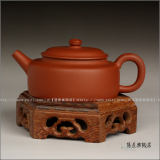wyardley wrote:I've read the book and honestly, I'm quite skeptical of the author's assertions (especially since he tries to act as if his observations are the result of scientific experimentation when they're clearly not). Whether or not there's a kernel of truth in what he's saying, I don't think he backs up his assertions very well. Also, I don't agree with his conclusion that very small pots are not ideal for making tea.
And even if his theory is true, to determine what tea(s) a pot is ideally suited for would require almost impossible amounts of trial and error. And the granularity of his choices, and the vast differences in the type of clay suited to two very similar teas doesn't make sense -- if high fire da hong pao is ideally suited to a tall, pitcher-shaped high-fired red clay, why would a high fire tie luo han be suited to a short purple clay pot? Since the properties of the tea are similar, almost identical, why wouldn't the pots suited for them be similar or identical. If I understand his theory right, it has to do with the oils from certain teas fitting through the micro-pores in certain pots and not through others. I have a hard time believing that the oils in different subvarietals of tea (and the size of pores in zisha) have properties that are so narrowly-defined and specific.
One other problem with his theory is that shape (which I think most people would agree can, and does, play a role in the way a pot makes tea) wouldn't really come into play if the properties of the clay are all that matters. And he doesn't seem to take processing (level of roasting / oxidation) into account at all.
However, since most of us don't have access to the types of pots the author of the book things are suitable (he asserts that master-made pots are the only ones with good quality clay), if you believe him, you could always say that we all just have crappy pots with bad clay, and that's why we're unable to see the same sort of results he does. I will happily accept donations of master-made antique Yixing for "scientific research". PM me for my address. I cannot guarantee that the pots will be returned.
The book is nice for the pictures, but IMHO, not at all worth the greatly inflated prices the book goes for (since it was censored by the Malaysian government, it's been out of print for a while).
Hi wyardley,
Thanks for your insightful thoughts.
Yes, I agree with you that some of his theory is very hard to accept, especially when he claims that small teapots are not suitable for making tea. I've got plenty of small teapots that makes great tea!
I've met him in person a couple of times and he is a very opinionated rich old man who has all the millions to spend on artisan teapots who only churns out top quality clay teapots. Some of the teapots there cost as much as RM180,000.... that's approx USD50,000 per teapot!
Like I mentioned, there have been very strong opinions regarding his claims, even here in Penang itself! Some feels that it's simply a psychological gimmick.
Though I may not agree entirely with his claims, but he definitely has plenty of good pictures in there

Most of the teapots are his personal collection. Don't worry, I use crappy pots too, when compared to the author's collection... ehehe... Please accept my apologies if I've offended you or your collections of teapots.
I personally don't fancy collecting artisan teapots as they are way too far beyond my financial reach. But I do source out for IMO good quality vintage teapots (somewhere within the range of 20 - 100 years old).
One man's meat, may be the other's poison.... the bottom line here is... we all enjoy drinking tea and we love our teapots... iregardless of size, shape, clay, age or source.
Cheers!

